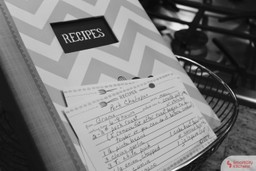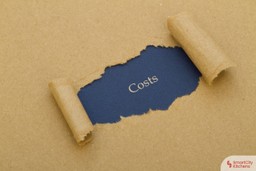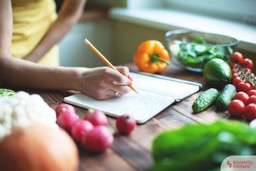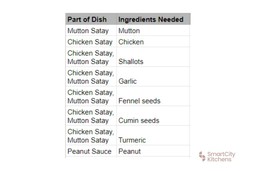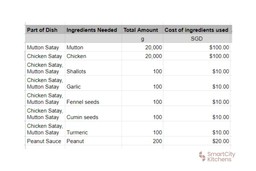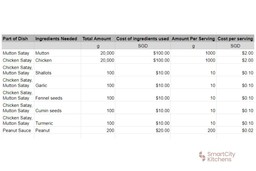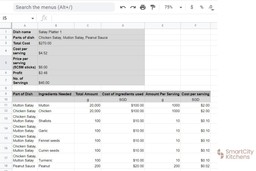If you’re a seasoned F&B business owner, you’re probably familiar with the practice of recipe costing. If you’re new to the industry or have just opened up your first CloudKitchens® delivery kitchen, you may still be unclear or have questions about this important topic.
So, first off, what is the recipe costing? Recipe costing is figuring out the total cost of a dish by breaking down each ingredient and calculating exactly what amount of money your restaurant incurs in preparing food. This involves knowing exactly which ingredients—and how much—are needed to make an edible portion of that dish.
Also as important is food costing, where restaurants determine the cost of each individual dish for the menu. Ideally, you would want to maximise your profits without compromising the number of that menu item being sold. Pricing your dish too high may deter your customers from ordering that dish, but at the same time pricing your dish too low would reduce your profits. Finding the right balance is what food costing will allow you to keep sales for that dish as well as happy customers coming back for more.
Imagine what would happen if you weren’t calculating your dish preparation costs correctly and the price being paid for that dish by your customer wasn’t enough to cover the incurred costs. Your business would be in serious trouble, right? That’s why it’s so important and why we’re taking you step-by-step on how to calculate recipe and food costing the right way, including sample formulae you can refer to.
Why recipe and food costing is important in restaurants
Recipe costing is a critical element of your F&B business operations. Here’s why:
- When you know how the costs you incur in preparing every dish, you get a solid understanding of how much you can earn per dish. This can help you decide which dishes are more profitable and which items you can remove from your menu.
- Once you know how much you can earn, you have a solid base for setting the price of that dish on the menu. After all, you want to maximise your profits!
- It provides a clear guide on when menu changes and/or recipe cost reductions are needed. If you see that a certain menu item is costing you more than expected, you can decide how to reduce the cost of preparing that recipe or remove it altogether.
- Recipe costing and knowing what your high profit-margin dishes are will help to determine which menu items to include in special promos and offers.
In short, understanding both recipe and food costing can save your restaurant money without compromising food quality or the trust of your existing customer base. As we walk you through the proper recipe costing steps, it’s important to remember that the final goal is to determine how much it takes to make one serving of that dish—that is, the amount of food you serve for every order of that specific item. Let’s begin!
5 steps to do recipe costing the right way
Step 1: Write down all recipe ingredients and their quantities
Basically, dissect the recipe! Write down every ingredient and note the measurement and weight of each one. This requires looking at your entire menu and doing this exercise for every recipe you offer. Doing so will allow you to quantify how much of each item you need when you prepare food for your customers. On top of this, the information you have noted down here will be used in the formula when you calculate the recipe costing.
For example, if you’re a CloudKitchens® delivery kitchen that cooks up traditional Singapore food and Satay is on your menu, you’ll need to write down every ingredient that’s needed to make an entire Satay recipe.
You need to write down the type of meat (plus any ingredients needed to prepare that meat), shallots, garlic, turmeric, fennel seeds, cumin seeds, plus any other special ingredients in your restaurant’s version of the recipe requires—and their quantities. Does your restaurant serve the Satay with sauce? When you’re calculating your recipe costing, you’ll need to break down every ingredient of that sauce recipe as part of your food cost too.
Step 2: Find the price for each ingredient
The second step requires figuring out the cost of every ingredient as it’s sold as a unit from your vendor or store. Here you’re just looking for the total price of each ingredient item, not how much of the item you’re using for each recipe. For example, if you purchase 20kg worth of Chicken, you need to fill in how much it will cost you. Keep in mind that buying inventory for your restaurant in higher amounts can mean discounts from your supplier. This can help you prepare food costing later on.
Step 3: Calculate the price of the portions used
To make this calculation, simply follow the costing formula provided. Divide the measurement or weight of each food ingredient by the weight of the unit in which it’s sold. Then, multiply that number by the price of the whole unit. This number tells you the cost of each ingredient that’s used in that recipe.
Step 4: Add it all up
Once you’ve done step 3 for every ingredient in the recipe and arrived at a cost for the portion of each ingredient that’s needed, you can add up all the numbers. The final number represents the total cost of that particular recipe.
Step 5: Figure out the cost of each serving
To arrive at the cost of each serving, simply divide the cost of the entire recipe by the number of serving it yields.
If you’re a delivery kitchen owner, the good news is that the turn-key process of opening and operating your business lowers your costs significantly and yields higher profits much quicker than in traditional restaurants. Just remember that a miscalculation in your recipe budgeting can make a big dent pretty quickly, so be sure to stay on top of your recipe and food costing practice.
Using this data to find out your profits
Once you have a clearer picture of how much individual servings are costing you in terms of food, you can perform a simple calculation to work out your profits with the formula below. Simply take the revenue you made cooking a certain number of dishes and subtract the total cost it took you to make that same number of dishes.
- Cost of ingredients used = (amount of ingredients used/the total amount bought) * the cost of the total amount
- Cost per serving = the cost of all the ingredients used/the number of servings
- Profit = (revenue/number of servings) – (cost/number of servings)
Still feeling overwhelmed by recipe costing? Join us as a CloudKitchens® licensee, and we will guide you through every step of the way. Fill up the form below to get in contact with us!
Find the recipe costing template here.
